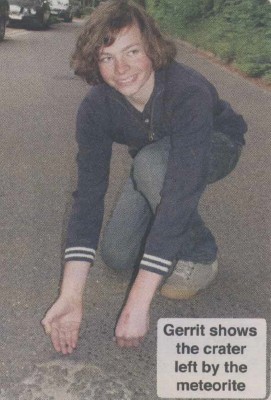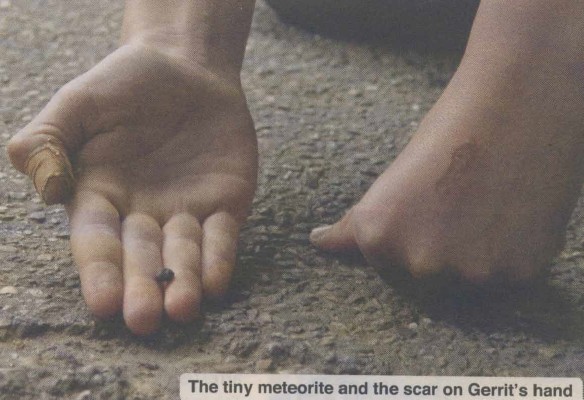
The Solar System consists not only of the Sun, the planets and their satellites (their “moons”) but also many other objects: particles of rock and dust, asteroids and comets, and lots of other things left behind when the Sun and the planets and their moons were formed. These objects range in diameter from less than 1 mm to more than 100 km.
These objects are all orbiting the Sun, like the planets, but their orbits are affected not only by the Sun’s gravity but also by the gravity of everything else in the Solar System, including the Earth’s, and even by the solar wind. Sometimes this can change the orbit of one of these objects so that it may come near the Earth. As it gets nearer the Earth
The object may be approaching the Earth at more than 40 000 km/hr. If it comes within about 100 km of the Earth’s surface the atmosphere slows it down. The very tiniest particles (specks of dust far smaller than a grain of sand) have very little kinetic energy and slow down so quickly that they do not get hot, and will eventually fall to the ground harmlessly and unnoticed. But as explained later on this Page any particles larger than this have much more kinetic energy so travel through the Earth's atmosphere for far longer at high speed, and the air resistance on them heats them up to a very high temperature. They may leave a trail of ionised gases behind them, and at night we may see this as a streak of light across the night sky. We call this streak of light a shooting (or falling) star or a meteor. Correctly the term meteor refers to the streak of light, and the object causing it is called a meteoroid. It is important to remember that the streak of light is produced by ionised gases and is not the meteoroid itself burning up. Few meteors are bright enough to be seen during the day, and the trails are seldom visible for more than a few seconds, but on a clear night you should see at least one every fifteen minutes. But you have to be patient and wide awake!
About a hundred tonnes of space dust and small meteoroids (less than 1 m in diameter) enters the Earth’s atmosphere every day.
Of course all the other planets in the Solar System and their moons are also being bombarded in the same way. The effect of this bombardment on the planet or moon depends upon whether it has an atmosphere and what the atmosphere is made of. The Earth’s Moon has no atmosphere so its surface is completely covered with craters made by objects from space hitting it.
Most meteors are produced by particles of space dust and cannot be predicted and can appear from anywhere in the sky. We call these sporadic meteors. But at certain times of the year the Earth passes through a cloud of particles, such as the debris left behind by a comet, and then we have a meteor shower, with several meteors every minute, and all of them starting from the same point in the sky (the radiant). We name these showers after the name of the constellation containing the radiant, or a bright star near it. On the night of a meteor shower we just have to look in the direction of this constellation or star and we shall be sure to see lots of meteors.
In England the best meteor showers are
There is usually something about these showers on television or in the newspapers at the time.
You can find out more about these and other meteor showers by visiting a Meteor Shower web site.
Meteoroids with a diameter of more than 1 m are nearly always asteroids, that is, objects that originally started their journey towards the Earth in the asteroid belt, so the word meteoroid is usually used only for objects smaller than 1 m. Many asteroids just skim the edge of the atmosphere before going back into space. In 1972 an asteroid with an estimated diameter of about 10 m skimmed the atmosphere above the Grand Tetons in Wyoming. Although it was daytime the trail it left was bright enough to be clearly visible, and several tourists were able to photograph it. Here is a photograph taken by James M Baker.

Most asteroids and meteoroids that do not go back into space burn up completely or air burst in the Earth's atmosphere. Only a few actually hit the surface of the Earth: we call these meteorites. About a hundred and fifty meteorites hit the Earth every year but most fall in the sea. Only a very few of those which hit the land are big enough to do more than minor damage over a small area.
In the Summer of 2009 a fourteen year old German schoolboy was struck on the hand by a pea-sized meteorite. It burnt his hand, leaving a scar, before bouncing off and making a crater 30 cm across in the pavement.


The kinetic energy, and so the destructive power, of an asteroid depends upon its mass, and so on its volume. The volume of a sphere depends upon the cube of its diameter, so if we double the diameter we multiply its volume, and so its mass, by a factor of two cubed, or eight. So a 2 m diameter asteroid has eight times the destructive power of a 1 m meteoroid, and a 10 m asteroid a thousand times as much! The actual amount of damage an asteroid will do if it hits the Earth or air bursts depends not only upon its mass but also upon its speed and the angle at which it enters the atmosphere.
The destructive power of an asteroid, or nuclear weapon or other explosion, is measured in kilotons or Megatons. One kiloton is the destructive power of a thousand tons of TNT, an explosive widely used in bombs during the Second World War. The atom bomb dropped on Hiroshima in 1945 was about 13 kilotons, and a 10 m asteroid has an energy of about 47 kilotons as it enters the atmosphere. (If you want the energy in joules 1 g of TNT releases 4184 J so you can do the calculation for yourself, but the answer is quite big...)
On 15th September 2007 a meteorite with a diameter of about 1 m fell in a remote area of Peru leaving a crater about 15 m in diameter and about 5 m deep. No one was killed but several hundred people were affected by gases produced by the impact.
Meteorites are important to scientists because they have come from outside the Earth and so they can tell us a lot about other planets and the origins of the solar system. There are three main types of meteorite: stony ones, made of rocks, iron ones, containing iron, and stony/iron ones, containing both rock and iron. Until Man learned how to extract iron from iron ore (about 2000 BCE but see the page on Metals and Alloys), iron meteorites were the only source of iron, and objects made of meteoric iron were more valuable than gold. There was a dagger made from meteoric iron in Tutankhamen's tomb. There was also a pectoral (a piece of jewellery worn on the breast) containing a piece of glass formed by an air burst over the Sahara Desert.
Very occasionally, every few thousand years, a large asteroid enters the Earth’s atmosphere. About 50 000 years ago an asteroid about 100 m in diameter entered the atmosphere and the resulting meteorite left a crater more than a kilometre across. To see a picture of this crater you can go to Arizona Crater, or do an Image Google search on Arizona Crater to see lots more.
Usually however an asteroid gets so hot that instead of hitting the Earth’s surface as a meteorite it explodes several kilometres above it: this is called an air burst. Air bursts may cause intense heating of the ground directly underneath and create very powerful shockwaves which can do great damage, but they leave no crater, so after a few years very little evidence remains. For this reason until recently almost nothing was known about them. But air bursts may be the origins of stories about a fire in the sky which form part of the traditions of Native American and other cultures.
In 1908 the air burst of a 50 m diameter asteroid over Tunguska, a very remote region in Siberia, destroyed 2000 km2 of forest (about the area of London), although because of its remoteness and the impact of the Russian Revolution and the First World War it was not properly investigated for many years.
On February 15th 2013 a 17 m diameter asteroid air burst over Chelyabinsk, a town in the Ural Mountains in Russia. No one was killed but more than a thousand people were injured, mainly by flying glass from windows broken by the shockwave. There are lots of web sites giving more details, even videos. Its mass is estimated as 105 kg (100 tonnes in standard form), but some web sites and newspapers, written by people unfamiliar with standard form, gave it as 105 kg (not much more than you)! You cannot always check that the information on a web site is correct, but you really should always check that it is sensible.Although this asteroid was totally unpredicted its path through the atmosphere was filmed by so many CCTVs and car dashcams, and from an area covering several km², that its trajectory could be plotted very accurately, and from this its orbit before it entered the Earth’s atmosphere and its mass and velocity could be calculated.
At the air burst the asteroid broke up into thousands of much smaller pieces. Most of these burnt up in the atmosphere and only a very few reached the Earth’s surface. None of these pieces left more than tiny craters or did more than minor damage, but as many as possible are being collected by scientists and local people because, as said above, we can learn a lot about the origins of the Solar System from them.
Very rarely indeed, every few million years, a very large object (a planetessimal), too big to air burst, hits the Earth. Most scientists now believe that the Great Extinction of sixty five million years ago which wiped out all the dinosaurs was the result of a planetessimal about 10 km in diameter (the size of Mount Everest) hitting the Earth. This struck the Earth at a place called Chicxulub, in Mexico, and left a crater 180 km across, although of course after 65 million years none of this crater can be detected on the surface.
Astronomers have identified about 127 Near Earth Objects (NEOs), asteroids which might come very close to the Earth and cause Megaton damage if they actually entered the atmosphere. A NEO with a diameter of about 370 m and with the unromantic name 2004 XP14 passed 340 000 km from the Earth (almost as close as the Moon) on 3rd July 2007. A smaller NEO called 2012 DA14 with a diameter of about 50 m passed about 27 000 km from the Earth on 15th February 2013 - this is much closer than the Moon and closer even than television satellites. It is a most amazing coincidence, but no more than a coincidence, that this is the same day that, as described earlier on this Page, a 17 m asteroid air burst over Russia.
An asteroid with a diameter of about 1 km (ten times bigger and therefore a thousand times more powerful than the asteroid which made the 1 km crater in Arizona) will, if it stays in its currently predicted orbit, hit the Earth on March 16th 2880. However it is not at present possible to be given eight hundred years notice of all asteroids big enough to do Megaton damage: even a 10 m asteroid would do nearly 50 kilotons of damage at ground level if it fell on a city as a meteorite rather than burst in the atmosphere, but spotting this more than twenty four hours before it hit is like spotting a grain of sand 100 km away! There are lots of people talking about ways of protecting our World from catastrophic asteroid strikes but so far no one is actually doing anything.
You can visit the Near Earth Object web site for more information about NEOs and how we might protect ourselves from them.
© Barry Gray January 2010, last revised March 2013